Periodontal Therapy - Torrance, CA
Fights Back Against Gum Disease
Good gum health is a crucial part of a strong and beautiful smile. And, as the gateway to the rest of your body, your gums also greatly affect your overall health. It’s important you keep your gum tissue healthy -- and Dr. Maria Galvan is your periodontist who is ready to help you do just that with periodontal therpay in Torrance, CA.
Gum Disease Facts
Did you know that 75% of Americans over the age of 35 suffer from gum disease, or periodontitis? This condition has been linked to serious heart problems, including cardiovascular disease, stroke, and high blood pressure. It’s also known to affect and be affected by blood glucose levels, meaning gum disease sufferers may be more likely to have diabetes, too.
Signs you may be dealing with gum disease include:
- Red, swollen, and bleeding gums
- Chronic bad breath
- Increased tooth sensitivity
- Gum recession
Dr. Galvan provides gum disease therapy in Torrance. In its early stages, gum disease can be reversed with increased at-home care and extra visits to the dentist. For more moderate forms of the condition, nonsurgical treatment includes scaling and root planing, or a deep cleaning to remove tartar and bacteria buildup above and below the gum line. In gum disease’s most severe form, surgical treatment may be required. This all may be combined with antibiotics, too.
Scaling & Root Planing

Think of this as a dental cleaning that is specifically focused on the gums and roots of the teeth. First, an ultrasonic cleaner will be used to remove any plaque and tartar that has built up around the gum line (scaling), and then the rough surfaces of the teeth’s roots will be gently smoothed out (root planing). This will make plaque and bacteria less likely to gather on them in the future, lowering the chances of reinfection.
Do I Need Scaling & Root Planing?

In the early stages of gum disease, the condition might be reversible via very conservative means. For example, some changes to your brushing and flossing habits might be enough to get your oral health back on track. However, if the problem worsens, it is quite likely that you will need scaling and root planing. Here are some signs that you should visit your dentist:
- Your gums bleed easily when you brush.
- Your gums are red and swollen.
- You have chronic bad breath.
- There is visible plaque buildup along your gumline.
- Your gums are receding.
The Process of Scaling & Root Planing

Scaling and root planing often requires two or more appointments. The treatment has two main phases:
- First, we use an ultrasonic scaler to remove plaque and tartar from the teeth, both above and below the gumline. We clean as much of the teeth as the gum pockets allow.
- Once the scaling is completed, we move onto root planing. We smooth out the roots of the teeth so it is more difficult for bacteria to cling to them. This results in a lower chance of future infections.
We use local anesthesia during the procedure, so you will not feel pain. However, you may experience some pressure as our team is working.
Aftercare Tips for Scaling & Root Planing

It can take a few weeks for your gums to feel normal after a scaling and root planing treatment. To reduce sensitivity and discomfort, you may find it beneficial to:
- Regularly rinse your mouth with warm salt water.
- Be gentle when brushing and flossing your teeth.
- Avoid spicy, acidic, hot, and cold foods.
- Eat a soft diet for at least 48 hours following your appointment.
Soft Tissue Laser Dentistry
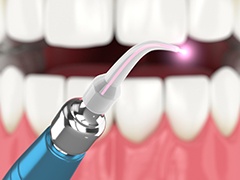
Treating your gum disease doesn’t have to involve scalpels. At our practice, we can use the Biolase Epic X Diode Laser for periodontal treatments. Soft tissue lasers have a number of advantages; not only are they extremely accurate, but they are also less invasive than other treatment methods. When you visit our office to discuss your options for addressing gum disease, don’t hesitate to ask about having a soft tissue laser treatment performed.
What Is Soft Tissue Laser Dentistry?
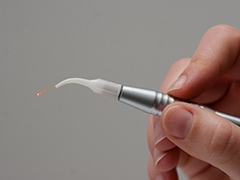
Laser is actually an acronym for “Light Amplification by Stimulated Emission of Radiation.” Simply put, it is a highly concentrated beam of light energy. A soft tissue laser can be used in place of a scalpel for specific dental procedures.
The precision of the laser makes it easier for dentists to only target the tissues that have been affected by gum disease while leaving healthy tissues alone. On top of that, lasers can help kill the harmful bacteria that can potentially cause infections, and they cauterize the treated area right away, which results in significantly less bleeding.
How Does It Work?

Before starting any sort of treatment, we will need to carefully examine your smile to get a feel for your oral health situation. After we have confirmed that you have gum disease, we can determine whether or not a soft tissue laser treatment is a viable option in your particular case.
Before the treatment begins, a local anesthetic may be applied for the sake of your comfort. However, in many cases, this is not a necessary step.
Our team will locate the tissue that has been affected by gum disease and use the laser to remove it. There will be little swelling or bleeding once the treatment is complete. Additionally, the laser will help stimulate the tissue and encourage it to heal.
Benefits of Soft Tissue Laser Dentistry

More and more oral health experts are using soft tissue lasers to treat gum disease. There are several advantages to using a laser that patients simply wouldn’t be able to enjoy with more traditional methods. Below are just some of the most crucial benefits:
- Increased Comfort: Patients who suffer from dental anxiety may find it easier to remain calm during a periodontal treatment performed with a gentle soft tissue laser.
- Reduced Need for Anesthetic: Soft tissue laser dentistry causes so little discomfort that a local anesthetic may not even be needed.
- Shorter Recovery Times: Your mouth will generally need less time to heal following a treatment where a soft tissue laser was used. On top of that, you can generally expect to experience less swelling, bleeding, and post-treatment discomfort.
- Lower Risk of Infection: Any exposed blood vessels are cauterized right away, which makes it less likely that an infection will occur during the recovery process.
Antibiotic Therapy

After an initial periodontal cleaning, Dr. Galvan may choose to apply a topical antibiotic in order to further fight the infection. For this, she’ll use Arestin, which is a powder-like substance that is actually made up of thousands of tiny microspheres, each one filled with a potent medicine. After it has been applied to the gums, it will slowly dissolve over the next two weeks or so, enabling the medicine to reach and kill even the most deeply hidden bacteria.
Who Needs Antibiotic Therapy?
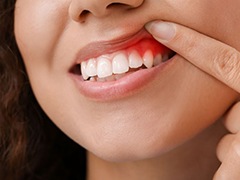
Arestin antibiotic therapy is typically reserved for individuals with chronic gum disease who must undergo scaling and root planing. Our team might recommend this treatment for you if:
- You have significant symptoms of gum disease, such as swelling, bad breath, gum recession, and more.
- Your medical history does not reveal any serious counterindications for the use of antibiotic gum disease therapy. For example, Antibiotic therapy with Arestin is generally not recommended for children or pregnant individuals.
Arestin is not available over the counter. Our team will have to perform a thorough evaluation of your situation before we recommend a customized treatment plan to get your gum health back on track.
How Does Arestin Work?

Arestin is applied at the same time as a scaling and root planing procedure. The powder is applied directly into the gum pockets, where it will be able to have the strongest effects. It combines with the moisture in your mouth so it can adhere securely to the infected tissue. The tiny medicine capsules in the powder continually release medicine for a couple of weeks, ultimately helping to rid your mouth of gum disease and moving you toward improved oral health.
Aftercare Tips for Antibiotic Therapy

Arestin antibiotic therapy should not cause any pain or discomfort. If any side effects occur, they are usually quite minimal.
Here are some tips that may help you make sure that you are getting the greatest possible benefits from your Arestin treatment:
- Do not eat or drink for the first 30 minutes after your treatment.
- Avoid touching the treated areas with your tongue or fingers.
- Wait at least 12 hours after your treatment before you brush your teeth.
- Do not use floss or other oral hygiene tools that are meant to clean between your teeth for at least 10 days.
- Do not consume foods that might damage your gums (such as chips, popcorn, or extremely hot items).
- Do not smoke or chew tobacco.
- Attend all recommended follow-up appointments with our team so we can monitor your progress as you strive to achieve improved oral health.
Gum Graft Surgery
Your gum tissue cannot regenerate, and once it’s lost, it’s gone forever — unless we perform a gum graft. Gums that have experienced severe recession as a result of gum disease, aggressive brushing, or some other factor can be made whole again with a gum graft. To perform this treatment, Dr. Galvan removes a portion of tissue from the roof of the mouth and places it on the gums to cover the exposed tooth roots.
What Causes Gum Recession?
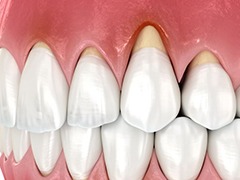
Gum recession is often the result of gum disease, an infection that eats away at the gum tissue, causing it to pull away from the roots of the teeth.
Other possible causes of gum recession include:
- Genetics
- Long-term bruxism (teeth grinding and clenching)
- Overly aggressive brushing
- Improper flossing techniques
- Tongue piercings
- Misaligned teeth
- Injuries
- Aging
- Hormonal factors
Regardless of what is causing your gums to recede, our Torrance team may be able to address the problem via gum grafting.
How Does Gum Graft Surgery Work?
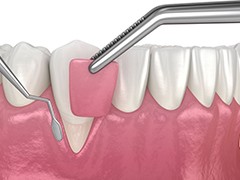
There are a few different types of gum grafts. The surgery that we perform most often in our practice requires that we take a small piece of tissue from the roof of your mouth. We attach it to the site of the lost gum tissue. As you heal, the graft should integrate with your existing gums and help to protect your sensitive tooth roots while also enhancing your smile.
Although the idea of gum graft surgery might seem a bit intimidating, you can be confident that we do everything in our power to make our patients comfortable during procedures. We even offer multiple levels of sedation, so you can expect to feel little to nothing while our team is working.
Aftercare Tips for Gum Graft Surgery

On average, recovery from gum graft surgery takes 1 – 2 weeks. Before you leave our office, we will provide detailed post-op instructions to facilitate a smooth and complication-free healing experience. For example, we might urge you to:
- Modify your eating habits. Crunchy and hard foods might irritate your surgical site, so it is best to stick to soft foods. Hot and spicy foods should also be avoided. Cold foods are fine as long as you chew them on the opposite side of your mouth from where you had your procedure.
- Take medications as directed. You may choose to take mild pain relievers.
- Regularly rinse with warm salt water. Gently swishing with warm salt water after meals can clean your mouth and help to reduce swelling and inflammation.
- Apply a cold compress. This can help to keep swelling to a minimum.
- Get enough rest. Your head should remain elevated above your heart so blood does not rush to your gums.
- Call us if you have questions or concerns. We are deeply interested in your recovery, so do not hesitate to reach out if you experience any unusual or severe side effects after your surgery.
Periodontal Pocket Reduction
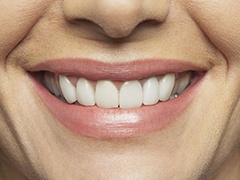
For patients suffering from gum disease, periodontal pocket reduction removes the bacteria and tartar that has collected at the root of the tooth. This buildup cannot be eliminated with simple dental hygiene or a deep cleaning and will continue to eat away at the bone and gum tissue until a tooth extraction becomes necessary. Periodontal pocket reduction helps to drastically lower the risk of tooth loss.
How Does Periodontal Pocket Reduction Work?
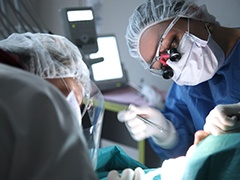
In patients with advanced gum disease, deep pockets form between the teeth and gums. These pockets collect harmful bacteria, which allows the gum disease to continue worsening. The goal of periodontal pocket reduction is to clean the tooth roots and reduce the depth of the spaces between the teeth and gums.
Here is an overview of what happens during the surgery:
- We numb the mouth and possibly administer sedation to ensure patient comfort.
- We create a flap in the gum tissue so we can fold it back and access the tooth root.
- We clean the tooth roots and remove diseased tissue.
- If necessary, we smooth and shape the bone around the tooth so it is more difficult for bacteria to cling to it. In some cases, this involves the placement of a bone graft.
- We reattach the gum flap in a way that reduces the overall depth of the periodontal pocket.
If we recommend periodontal pocket reduction for you, you might need to visit us for multiple procedures; it depends on how many of your periodontal pockets need to be treated.
Benefits of Periodontal Pocket Reduction

Some remarkable benefits of this procedure include:
- It removes plaque and tartar that cannot be reached during a typical deep cleaning of the mouth.
- By reducing periodontal pocket depth, we minimize the potential for gum disease to continue worsening.
- Periodontal pocket reduction may play a role in eliminating the need for tooth extractions.
- This surgery can play a key role in your recovery from gum disease, meaning that it can help to protect your overall health.
Aftercare Tips for Periodontal Pocket Reduction

Recovery from periodontal pocket reduction can take a few weeks (though you should be able to resume most normal activities within a few days). Here are some tips that can support your body’s healing process:
- Get plenty of rest. Engaging in vigorous physical activity too soon could cause discomfort and slow down your recovery.
- Avoid hard and crunchy foods. Instead, eat soft foods that are easy to chew and not too hot.
- Take anti-inflammatory pain medications as necessary. This can minimize discomfort at your surgical sites.
- Regularly rinse your mouth with warm salt water or an antibacterial mouthwash. Doing so can reduce inflammation and lower your risk of postoperative infections.
- Attend all recommended follow-up appointments with our team. We want to monitor your recovery and continue guiding you on your journey toward optimum oral health.
- Call us if you have concerns. Postoperative complications are rare, but you should still keep a close eye on your mouth and reach out to us if anything seems amiss.
Dental Crown Lengthening

When a tooth needs to be fixed with a dental crown or filling, it needs sufficient structure to support the restoration. If enough of the tooth isn’t present outside of the gums, a dental crown lengthening procedure can create more space for the restoration. This treatment removes excess gum tissue to reveal more tooth enamel. It may also be used for cosmetic reasons for patients who feel they have a “gummy smile.”
Who Needs Dental Crown Lengthening?
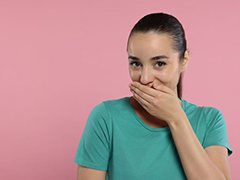
We might recommend that you undergo dental crown lengthening if:
- You need a dental crown. A dental crown can protect a damaged tooth from further harm and renew its function. However, in order for a crown to stay secure, it needs to be firmly attached to the underlying tooth. Crown lengthening can make this possible.
- You are interested in getting veneers. Just like dental crowns, veneers need adequate enamel beneath them. If your gums are covering too much of your tooth enamel, crown lengthening might be necessary.
- You want to enhance the proportions of your smile. Crown lengthening or a similar procedure known as gum recontouring can make your smile look more proportionate.
- Overgrown gum tissue is threatening your oral health. If your excess gum tissue tends to get easily irritated or traps food in it, crown lengthening might be suitable for you.
How Does Dental Crown Lengthening Work?
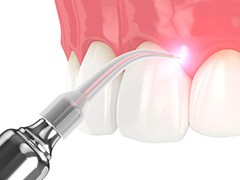
Here is an overview of the crown lengthening procedure:
- We make you comfortable. In addition to administering local anesthesia, we might also sedate you.
- We remove excess gum tissue. We use a soft tissue laser for this part of the procedure; it is very precise and contributes to shorter recovery times and reduced postoperative discomfort.
- We may also reshape the bone. In some cases, the crown lengthening procedure involves modifying the part of the jawbone that supports the teeth.
Depending on the details of your case, we may need you to attend multiple appointments so we can perform crown lengthening on different areas of your mouth at separate times.
Aftercare Tips for Dental Crown Lengthening
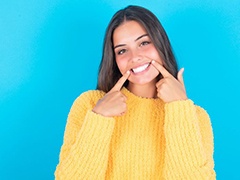
Before you go home from your crown lengthening procedure, we will give you detailed postoperative instructions. We might advise you to:
- Modify your diet. For example, you may need to avoid hard and crunchy foods for a while. Extremely hot items should also be avoided.
- Be careful with oral hygiene. You can start brushing your teeth after 24 hours. You should be very gentle when cleaning the treated areas. You may need to avoid flossing for a week or so.
- Take medications as prescribed. You might need to take pain relievers to minimize your discomfort.
- Use cold to minimize swelling. Sipping on cool water or applying a cold compress may help.
- Get enough rest. It is best to avoid strenuous physical activities for 2 – 3 days or so.
- Call us if you have concerns. We are always ready to assist patients in need. If you run into any worries or problems during your recovery, contact us right away.
